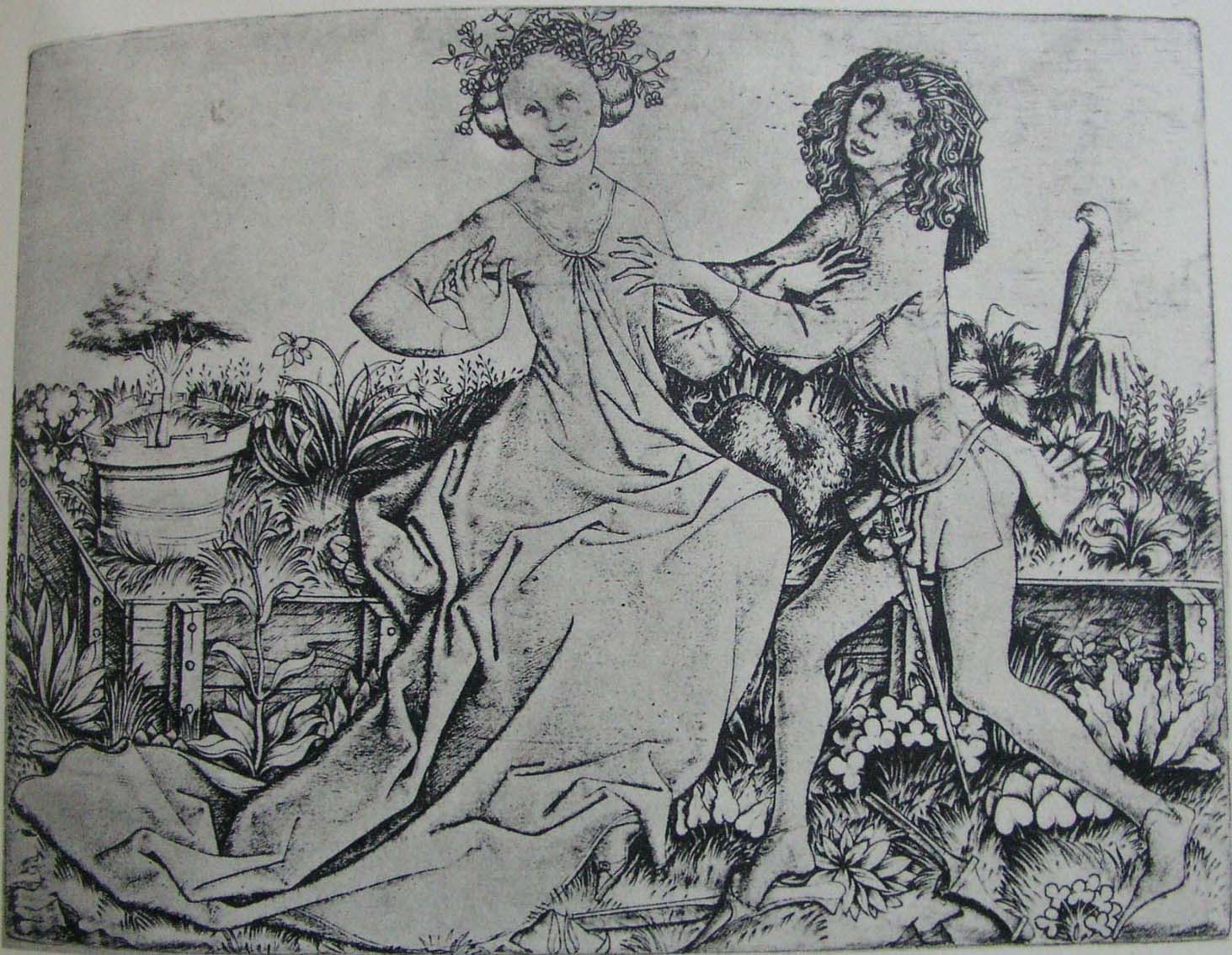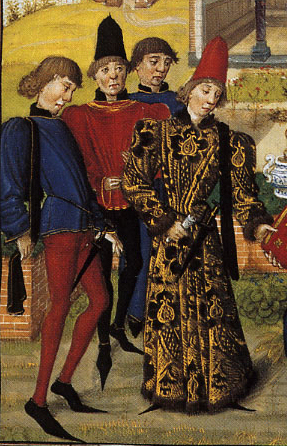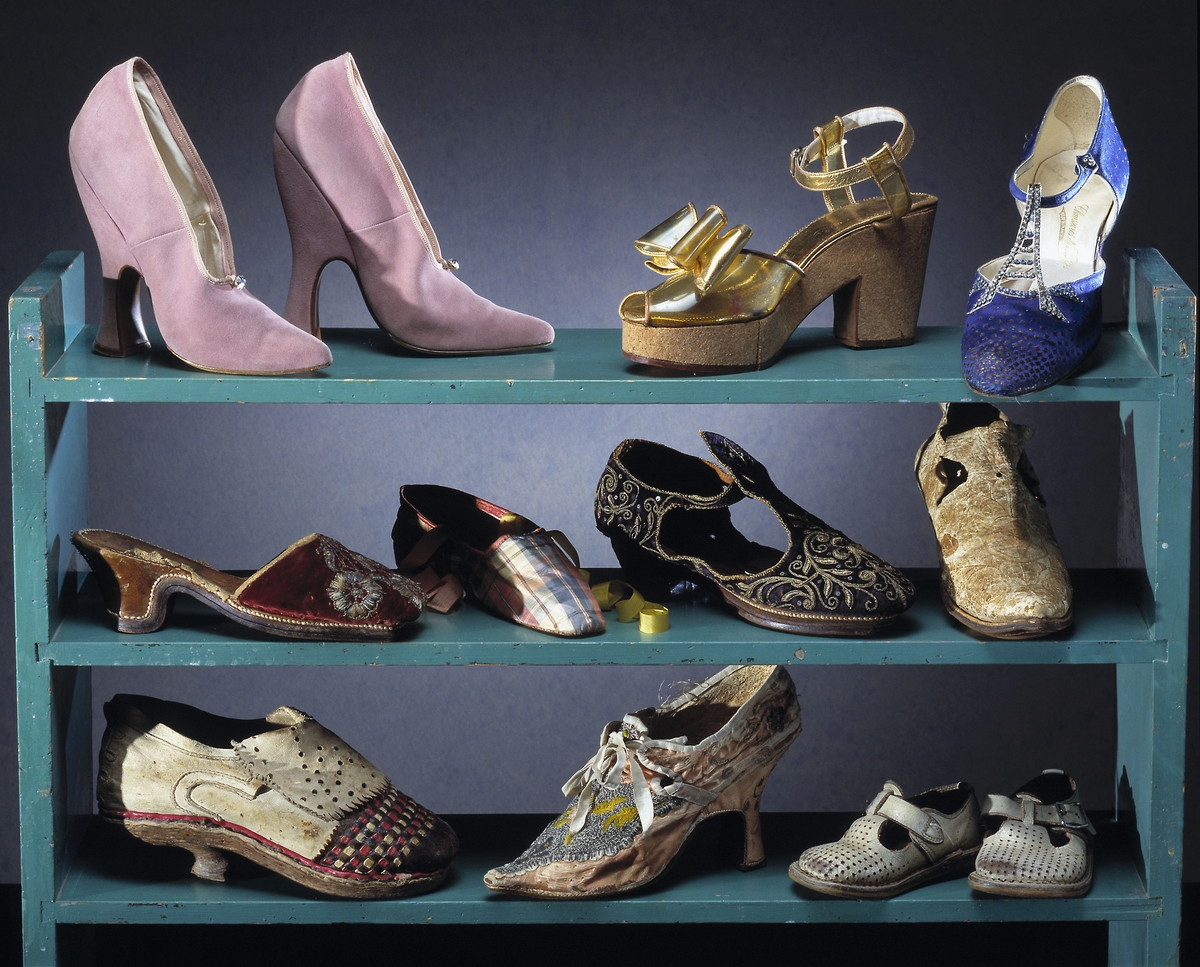|
Pattens
Pattens are protective overshoes that were worn in Europe from the Middle Ages until the early 20th century. Pattens were worn outdoors over a normal shoe, had a wooden or later wood and metal sole, and were held in place by leather or cloth bands. Pattens functioned to elevate the foot above the mud and dirt (including human effluent and animal dung) of the street, in a period when road and urban paving was minimal. Etymology The word ''patten'' probably derives from the Old French ''patte'' meaning hoof or paw. Women continued to wear pattens in muddy conditions until the 19th or even early 20th century. In appearance, they may resemble contemporary clogs or sandals, but though historical usage was apparently not always consistent, the term now is used only to describe protective overshoes worn over another pair of shoes. Medieval period Pattens were worn during the Middle Ages outdoors, and in public places, over (outside of) the thin soled shoes of that era. Pattens we ... [...More Info...] [...Related Items...] OR: [Wikipedia] [Google] [Baidu] |
Pattens
Pattens are protective overshoes that were worn in Europe from the Middle Ages until the early 20th century. Pattens were worn outdoors over a normal shoe, had a wooden or later wood and metal sole, and were held in place by leather or cloth bands. Pattens functioned to elevate the foot above the mud and dirt (including human effluent and animal dung) of the street, in a period when road and urban paving was minimal. Etymology The word ''patten'' probably derives from the Old French ''patte'' meaning hoof or paw. Women continued to wear pattens in muddy conditions until the 19th or even early 20th century. In appearance, they may resemble contemporary clogs or sandals, but though historical usage was apparently not always consistent, the term now is used only to describe protective overshoes worn over another pair of shoes. Medieval period Pattens were worn during the Middle Ages outdoors, and in public places, over (outside of) the thin soled shoes of that era. Pattens we ... [...More Info...] [...Related Items...] OR: [Wikipedia] [Google] [Baidu] |
Clog
Clogs are a type of footwear made in part or completely from wood. Used in many parts of the world, their forms can vary by culture, but often remained unchanged for centuries within a culture. Traditional clogs remain in use as protective footwear in agriculture and in some factories and mines. Although they are sometimes negatively associated with cheap and folkloric footwear of farmers and the working class, some types are considered fashion wear today, such as Swedish träskor or Japanese geta. Clogs are also used in several different styles of dance, where an important feature is the sound they produce against the floor. Clog dancing is one of the fundamental roots of tap dancing, but with tap shoes the taps are free to click against each other and produce a different sound from clogs. Types The Oxford English Dictionary defines a clog as a "thick piece of wood", and later as a "wooden soled overshoe" and a "shoe with a thick wooden sole". Welsh traditional clog ma ... [...More Info...] [...Related Items...] OR: [Wikipedia] [Google] [Baidu] |
Poulaine
Crakows or crackowes were a style of shoes with extremely long toes very popular in 15th century Europe. They were so named because the style was thought to have originated in Kraków, the then capital of Poland. They are also known as poulaines or pikes, though the term ''poulaine'', as in ''souliers à la poulaine'', "shoes in the Polish fashion", referred to the long pointed beak of the shoe, not the shoe itself. History Long-toed shoes had been popular in Europe at different times, first appearing in the archaeological record in the 12th century and falling in and out of fashion periodically. They reached their most exaggerated form in the third quarter of the 15th century before falling out of fashion in the 1480s. The arrival of this fashion in England is traditionally associated with the marriage of Richard II and Anne of Bohemia in 1382. An anonymous 'monk of Evesham' recorded in 1394: "With this queen there came from Bohemia into England those accursed vices (Englis ... [...More Info...] [...Related Items...] OR: [Wikipedia] [Google] [Baidu] |
Sole (shoe)
A shoe is an item of footwear intended to protect and comfort the Foot, human foot. They are often worn with a sock. Shoes are also used as an item of decoration and fashion. The design of shoes has varied enormously through time and from culture to culture, with form originally being tied to function. Though the human foot can adapt to varied terrains and climate conditions, it is still vulnerable to environmental hazards such as sharp rocks and temperature extremes, which shoes protect against. Some shoes are worn as safety equipment, such as steel-toe boots which are required footwear at industrial worksites. Additionally, fashion has often dictated many design elements, such as whether shoes have very high heels or flat ones. Contemporary footwear varies widely in style, complexity and cost. Basic sandals may consist of only a thin sole (shoe), sole and simple strap and be sold for a low cost. High fashion shoes made by famous Fashion design, designers may be made of expens ... [...More Info...] [...Related Items...] OR: [Wikipedia] [Google] [Baidu] |
Jan Van Eyck 004
Jan, JaN or JAN may refer to: Acronyms * Jackson, Mississippi (Amtrak station), US, Amtrak station code JAN * Jackson-Evers International Airport, Mississippi, US, IATA code * Jabhat al-Nusra (JaN), a Syrian militant group * Japanese Article Number, a barcode standard compatible with EAN * Japanese Accepted Name, a Japanese nonproprietary drug name * Job Accommodation Network, US, for people with disabilities * ''Joint Army-Navy'', US standards for electronic color codes, etc. * ''Journal of Advanced Nursing'' Personal name * Jan (name), male variant of ''John'', female shortened form of ''Janet'' and ''Janice'' * Jan (Persian name), Persian word meaning 'life', 'soul', 'dear'; also used as a name * Ran (surname), romanized from Mandarin as Jan in Wade–Giles * Ján, Slovak name Other uses * January, as an abbreviation for the first month of the year in the Gregorian calendar * Jan (cards), a term in some card games when a player loses without taking any tricks or scoring a mini ... [...More Info...] [...Related Items...] OR: [Wikipedia] [Google] [Baidu] |
Clergy
Clergy are formal leaders within established religions. Their roles and functions vary in different religious traditions, but usually involve presiding over specific rituals and teaching their religion's doctrines and practices. Some of the terms used for individual clergy are clergyman, clergywoman, clergyperson, churchman, and cleric, while clerk in holy orders has a long history but is rarely used. In Christianity, the specific names and roles of the clergy vary by denomination and there is a wide range of formal and informal clergy positions, including deacons, elders, priests, bishops, preachers, pastors, presbyters, ministers, and the pope. In Islam, a religious leader is often known formally or informally as an imam, caliph, qadi, mufti, mullah, muezzin, or ayatollah. In the Jewish tradition, a religious leader is often a rabbi (teacher) or hazzan (cantor). Etymology The word ''cleric'' comes from the ecclesiastical Latin ''Clericus'', for those belonging ... [...More Info...] [...Related Items...] OR: [Wikipedia] [Google] [Baidu] |
Willow
Willows, also called sallows and osiers, from the genus ''Salix'', comprise around 400 speciesMabberley, D.J. 1997. The Plant Book, Cambridge University Press #2: Cambridge. of typically deciduous trees and shrubs, found primarily on moist soils in cold and temperate regions. Most species are known as willow, but some narrow-leaved shrub species are called osier, and some broader-leaved species are referred to as sallow (from Old English ''sealh'', related to the Latin word ''salix'', willow). Some willows (particularly arctic and alpine species) are low-growing or creeping shrubs; for example, the dwarf willow (''Salix herbacea'') rarely exceeds in height, though it spreads widely across the ground. Description Willows all have abundant watery bark sap, which is heavily charged with salicylic acid, soft, usually pliant, tough wood, slender branches, and large, fibrous, often stoloniferous roots. The roots are remarkable for their toughness, size, and tenacity to live ... [...More Info...] [...Related Items...] OR: [Wikipedia] [Google] [Baidu] |
Populus
''Populus'' is a genus of 25–30 species of deciduous flowering plants in the family Salicaceae, native to most of the Northern Hemisphere. English names variously applied to different species include poplar (), aspen, and cottonwood. The western balsam poplar ('' P. trichocarpa'') was the first tree to have its full DNA code determined by DNA sequencing, in 2006. Description The genus has a large genetic diversity, and can grow from tall, with trunks up to in diameter. The bark on young trees is smooth, white to greenish or dark gray, and often has conspicuous lenticels; on old trees, it remains smooth in some species, but becomes rough and deeply fissured in others. The shoots are stout, with (unlike in the related willows) the terminal bud present. The leaves are spirally arranged, and vary in shape from triangular to circular or (rarely) lobed, and with a long petiole; in species in the sections ''Populus'' and ''Aigeiros'', the petioles are laterally flattened, s ... [...More Info...] [...Related Items...] OR: [Wikipedia] [Google] [Baidu] |
Diocese Of York
The Diocese of York is an administrative division of the Church of England, part of the Province of York. It covers the city of York, the eastern part of North Yorkshire, and most of the East Riding of Yorkshire. The diocese is headed by the Archbishop of York and its cathedral is York Minster. The diocese is divided into three archdeaconries of Cleveland in the north (with a Bishop of Whitby), the East Riding (with a Bishop of Hull), and in the south-west the Archdeaconry of York (with a Bishop of Selby). The diocese was once much larger, covering Yorkshire, Nottinghamshire and Derbyshire and parts of Northumberland, Lancashire, Cumberland and Westmorland. Bishops The diocesan Archbishop of York is primarily supported by three suffragan bishops: the Bishops of Hull (founded 1891), of Whitby (founded 1923) and of Selby (founded 1939). While not operating a formal area scheme, each suffragan takes informal responsibility for one archdeaconry (East Riding, Cleveland and York r ... [...More Info...] [...Related Items...] OR: [Wikipedia] [Google] [Baidu] |
Shlomo Ibn Aderet
Shlomo ben Avraham ibn Aderet ( he, שלמה בן אברהם אבן אדרת or Solomon son of Abraham son of Aderet) (1235 – 1310) was a medieval rabbi, halakhist, and Talmudist. He is widely known as the Rashba (Hebrew: ), the Hebrew acronym of his title and name: Rabbi Shlomo ben Avraham. The Rashba was born in Barcelona, Crown of Aragon, in 1235. He became a successful banker and leader of Spanish Jewry of his time. As a rabbinical authority his fame was such that he was designated as El Rab d'España ("The Rabbi of Spain"). He served as rabbi of the Main Synagogue of Barcelona for 50 years. He died in 1310. Biography His teachers were Nahmanides and Yonah Gerondi. He was a master in the study of the Talmud, and was not opposed to the Kabbala. Aderet was very active as a rabbi and as an author. Under his auspices and through his recommendation, part of the commentary on the Mishnah by Maimonides was translated from the Arabic into Hebrew. His Talmudic lectures ... [...More Info...] [...Related Items...] OR: [Wikipedia] [Google] [Baidu] |
Rabbi
A rabbi () is a spiritual leader or religious teacher in Judaism. One becomes a rabbi by being ordained by another rabbi – known as '' semikha'' – following a course of study of Jewish history and texts such as the Talmud. The basic form of the rabbi developed in the Pharisaic (167 BCE–73 CE) and Talmudic (70–640 CE) eras, when learned teachers assembled to codify Judaism's written and oral laws. The title "rabbi" was first used in the first century CE. In more recent centuries, the duties of a rabbi became increasingly influenced by the duties of the Protestant Christian minister, hence the title " pulpit rabbis", and in 19th-century Germany and the United States rabbinic activities including sermons, pastoral counseling, and representing the community to the outside, all increased in importance. Within the various Jewish denominations, there are different requirements for rabbinic ordination, and differences in opinion regarding who is recognized as a rabbi. For ex ... [...More Info...] [...Related Items...] OR: [Wikipedia] [Google] [Baidu] |
Crown Of Aragon
The Crown of Aragon ( , ) an, Corona d'Aragón ; ca, Corona d'Aragó, , , ; es, Corona de Aragón ; la, Corona Aragonum . was a composite monarchy ruled by one king, originated by the dynastic union of the Kingdom of Aragon and the County of Barcelona and ended as a consequence of the War of the Spanish Succession. At the height of its power in the 14th and 15th centuries, the Crown of Aragon was a thalassocracy controlling a large portion of present-day eastern Spain, parts of what is now southern France, and a Mediterranean empire which included the Balearic Islands, Sicily, Corsica, Sardinia, Malta, Southern Italy (from 1442) and parts of Greece (until 1388). The component realms of the Crown were not united politically except at the level of the king, who ruled over each autonomous polity according to its own laws, raising funds under each tax structure, dealing separately with each ''Corts'' or ''Cortes'', particularly the Kingdom of Aragon, the Principality of Catalonia, ... [...More Info...] [...Related Items...] OR: [Wikipedia] [Google] [Baidu] |








.jpg)
